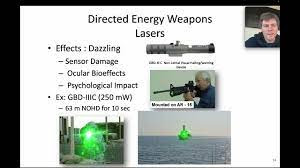Directed-Energy Weapons Research Becomes Official
Directed-Energy Weapons Research Becomes Official - by James C. Li

A sonic directed-energy weapon (LRAD) deployed in a civilian context in the US, during the 2014 Ferguson protests. The LRAD is the square dish assembly mounted on the roof of the central vehicle.
* * * * *
The incidents of sonic attacks on diplomatic personnel in Havana, Cuba, will likely remain a mystery until a culprit is found in the act. The one-time diplomatic affair, the Havana Syndrome, has apparently morphed into a weapons research program in the United States [1]. Indeed, it appears that research in high-power microwaves has persisted worldwide including that undertaken by some of the major military powers [2], [3].
An issue that has surfaced concerning the Havana Syndrome involves whether the microwave auditory effect can be exploited as a directed-energy weapon. Indeed, if the microwave auditory effect is weaponized, at sufficiently high powers, aside from microwave-pulse-induced sonic attacks, the high-power microwave pulses could produce putative lethal and nonlethal damage to brain tissues by the reverberating sonic shock waves.
A U.S. National Academies of Sciences, Engineering, and Medicine (NASEM) study committee [4]concluded that, among the mechanisms the study committee considered, the most plausible one to explain the accounts, especially in individuals with distinct early symptoms, appears to be directed, pulsed microwave energy. It reaffirmed the hypothesis first proposed in late 2017 and discussed at the two-day NASEM meeting in early 2020.
Many scientists and researchers, in and outside the U.S. government, are of the thinking that the microwave auditory effect—induced by a targeted beam of high-peak-power pulsed microwave radiation—is the most likely scientific explanation for the Havana Syndrome.
The resilience of the Havana Syndrome and its impact within governmental circles has been amazing. Speculations and hypothesized causes are being vigorously discussed five years since it was first reported. Over that period, about 200 U.S. personnel have reported similar attacks while working in places like Havana, Guangzhou, London, Moscow, Vienna, and Washington, D.C., to name a few.
There have been increasing discussions on the capability of high-power pulsed microwave radiation as a directed-energy weapon in military operations. Apparently, the U.S. military has maintained some interest on the topic of the microwave auditory effect. Some years ago, the U.S. Navy awarded a research contract titled, “Remote Personnel Incapacitation System” through its small business innovative research program [5], [6]. The goal of the project was to design and build a prototype nonlethal weapon based on the microwave auditory effect.
The transient personnel incapacitation system is dubbed MEDUSA (for Mob Excess Deterrent Using Silent Audio). The weapon relies on a combination of pulse parameters and pulse power to raise the auditory sensation to the “discomfort” level to deter personnel from entering a protected perimeter. While the status or outcome of this project may be privileged, there are indications that hardware was built and power measurements taken to confirm the required pulse parameters, enabling observation of the desired microwave auditory effect, as expected.
It is noteworthy that, in August 2020, the U.S. government announced a research program to develop low-cost, low-weight, small-size wearable microwave weapon exposure detectors [7]. All indications suggest the research program is currently in progress. Furthermore, the announcement acknowledged that directed-energy weapons, including microwave weapons, are a growing threat to soldiers on the battlefield. It also suggested that the determinants of a microwave weapon’s antipersonnel effects are multifactorial, and associated injuries may be situational dependent. Evidently, there is the conviction that some major military powers possess the capabilities of fielding high-power microwave sources like the ones that appear to have been used in Cuba and elsewhere. It appears that the research program has been put into place as advertised. Indeed, there are reports suggesting that research in high-power microwaves continues worldwide, including research by some of the major military powers [12].
The recent report from a joint research project conducted by the U.S. Air Force and U.S. Army suggests that relevant investigations may be ongoing within their institutions as well. A computer simulation study showed that, for certain high-power microwave pulse exposures, substantial acoustic pressure may occur within the brain that may have implications for neuropathological consequences [8]. Although the required power densities are high, they are achievable with current high-power commercial and military microwave systems operating under pulsed conditions. Significantly, they are within the permissible limits of currently promulgated safety standards, which confirms the conclusion of an earlier study [9]. Furthermore, the study showed that, to generate a tissue-injury level of high-power microwave-induced acoustic pressures inside the human brain, the theoretical microwave pulse-induced temperature elevation would be no more than 1 °C, which is “safe” according to currently promulgated RF and microwave safety protection guidelines [10], [11].
The required microwave technology is mature and, in general, commercially available in many developed countries or military powers. Longer distances and higher-power scenarios would require more bulky equipment and sophisticated aiming devices, but packable equipment is possible for closer-range nonlethal applications [3]. This would not preclude the use of a much higher-power microwave weapon located at a farther distance from the intended targets to raise the auditory sensation to the “discomfort” levels. Also, the existing hardware could be optimized to meet some specific requirements in covert or finely targeted operations.
A recent article [1] noted that the U.S. Air Force Research Laboratory (USAFRL) confirmed plans to establish a new center for research into directed energy, such as high-power electromagnetic (including microwave) energy applied to destroy a specific target—in collaboration with the University of New Mexico (UNM). Apparently, the UNM has been engaged with the USAFRL on directed-energy microwave systems for more than 30 years. The new center is in early planning stages. It is seeded by a US$2.4 million, four-year cooperative partnership agreement between the UNM and USAFRL. It is expected that the center will go into full operation by 2025. It will enable researchers to study and develop next-generation capabilities in the increasingly competitive directed-energy technology arena.
The program appears to be an integral part of the strategy contained in the U.S. Department of Defense’s “Directed Energy Futures 2060” report released in August 2021 [12]. The report defines visions for directed energy and some aspects of electronic warfare with respect to technology development, military utility, and proliferation.
The report mentions further that the United States is moving aggressively to retain leadership in directed energy, which it describes as focused beams of electromagnetic energy that can be used to disrupt or harm humans, devices, missiles, vehicles, and other targets. It suggests that the technology is not as costly as traditional kinetic systems and can result in less collateral damage. It mentions that the technologies are approaching or have passed a tipping point for the criticality of directed-energy capabilities as applied to the successful execution of military operations for the United States.
_____________________







Comments